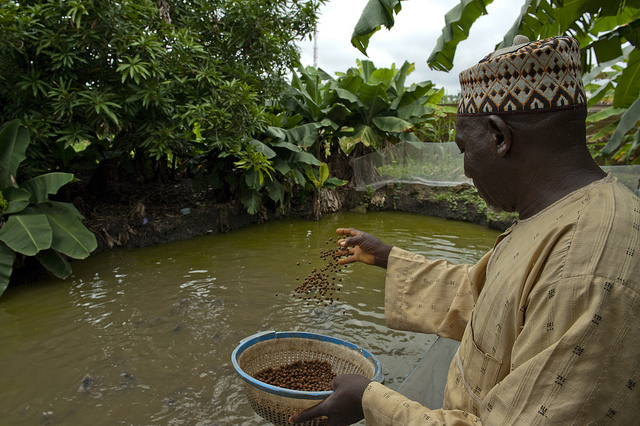 Over 300 dairy urban farmers in Uganda who have adopted backyard bucket fish farming are reaping from the symbiotic relationship with the nutritious waste water from the pond once mixed with animal feeds increasing milk production by up to three litres per milking while dried pounded cow dung sprinkled on the pond trapping harmful germs.
Over 300 dairy urban farmers in Uganda who have adopted backyard bucket fish farming are reaping from the symbiotic relationship with the nutritious waste water from the pond once mixed with animal feeds increasing milk production by up to three litres per milking while dried pounded cow dung sprinkled on the pond trapping harmful germs.
The model which was introduced to the farmers two years ago is gaining momentum and helping farmers especially those with little space engage into diversified investments. Joachim Birungi an agricultural expert fronting the adoption of the technology noted that the symbiosis relationship that exists between the fish and cow has for long been ignored by the farmers mainly due to ignorance. “We are fronting the bucket or tank fish farming among the smallholder farmers especially from urban areas. By successfully adopting the new fish farming technology, then one can gradually graduate into the dairy farming under the zero grazing model where he can maximize the waste from the fish as well as introduce to the fish the dried pounded cow dung/manure.”
The waste water from the fish tank which mainly houses Catfish that is ideal and able to survive under the technology is drained after 3-7 days. This water according to Joachim is rich in nutrients and minerals that are vital for the growth and efficiency of the dairy cows. The waste water from the fish tank is then mixed with dairy feeds like molasses, rice and maize brands. “The feeds are added to the nutritious water to tame the fish smell as well as make it a balanced feed. It’s full of protein and calcium and can help a farmer cut over reliance on other feed boosters that are costly and sometimes ineffective.”
|
Related news |
|
City dwellers insulate themselves from food price spikes with urban gardens Urban gardens gobble up toxins, protecting city dwellers Slum dwellers adopt urban farming as step up
|
Farmers using the water to mix the feeds are already counting higher returns and improved health of the animals. “Daily feeding on this mixture can help a farmer recognize increased milk production. For instance for a farmer who has been getting 7 litres per milking, the introduction of the water into the animal feeds will see the milk production shoot up to over 10 litres per milking,” explained Joachim. In addition the water solution is a cleanser to the blood stream of the animal and therefore helps improve blood circulation and general health of the animal.
On the other hand, a farmer who is using the solution can also enrich his fish project under tank or bucket by utilizing dried pounded cow dung. The cow dung is introduced to the pond in order to tap the ammonia which is toxic to the fish as well as phytoplankton which are micro plants for the fish. The dried cow dung is sprinkled into the fish tank twice or thrice before changing the water. “If ammonia is not dealt with, then the growth of the fish is compromised and therefore the fish will not gain the required weight at maturity level.” According to Food and Agricultural Organization, Integrating fish and cow farming reduces the necessity to purchase fertilizers and fish feeds, and increases the income generated by the fish farm. Moreover, cow manure can be dispersed by hand, saving money, labour, and energy and improving the environment.
The solution’s adoption among dairy farmers especially the one’s practicing zero grazing is quickly gaining momentum with many farmers from the milk zone of the country- western region welcoming it. Farmers from Mbarara and its’ environs have adopted it and Joachim noted that with over 300 farmers using the model, more doubters are also expressing interest. At first, there existed a gap between the technical knowhow and the farmers but after our heightened campaigns, many farmers are coming on board.
Among all livestock excreta, cow excreta is the most abundant and, in terms of availability, the most reliable. A 460-kg cow annually produces 13,600 kg of feces and 9000 kg of urine. The average amount of phytoplankton( microscopic plants that fish feed on) in a cow-manured pond still reaches 19.2+-6.5 mg/L, which is higher than that in control ponds and close to the lower limit of optimum food density. The average biomass of zooplankton will be 5.61 mg/L. The amounts of organic detritus and bacteriain manured ponds not only surpassed those in un-manured fish ponds but also exceeded those in the pig-manured ponds. The increase in natural food organisms, detritus, and bacteria in fish pond enables filtering and omnivorous fish to grow faster.
















Comments powered by CComment